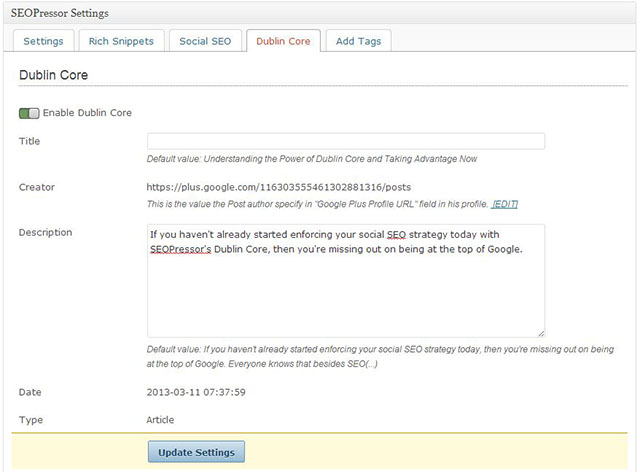Steph W. from SEOPressor


...help you check your website and tell you exactly how to rank higher?


84
score %
SEO Score

Found us from search engine?
We rank high, you can too.
SEOPressor helps you to optimize your on-page SEO for higher & improved search ranking.
By gymosphere on March 11, 2013
If you haven’t already started enforcing your social SEO strategy today, then you’re missing out on being at the top of Google.
Everyone knows that besides SEO, there’s content optimizing, and there’s social media optimization – the few things that help you rank well on search engines.
But at this day and age, everything advances so quickly and more standards and technologies are becoming a part of history.
Today, we talk about Dublin Core.
Dublin Core metadata is used to describe resources held, owned or produced by companies, governments and international organisations to supporting portal services or internal knowledge management.
Dublin Core metadata is also used as a common exchange format supporting the aggregation of collections of metadata, such as the case of the Open Archive Initiative. In these cases, like in the open environment of the Web, the concept of standardized descriptive metadata provides a powerful mechanism to improve retrieval for specific applications and specific user communities. It is this need for “standardized descriptive metadata” that the Dublin Core addresses.
What this basically means is that:
1) Dublin core is a type of metadata, something like Facebook’s Open Graph and Twitter Card tags
2) Dublin core is the set standard for all types of metadata online
We have Facebook Open Graph, Twitter card and now – Dublin Core will be the new standard for all metadata.
Dublin Core Metadata can be used for multiple purposes, one of them being simple resource description.
Some of these which you are probably already very familiar with such as:
“og:image”
“og:title”
“og:URL”
“og:site_name”
Just to a name a few.
The Dublin Core standard has 15 elements just like the ones above on the first level (known as Simple Dublin Core), and an additional 3 elements for its second level (Qualified Dublin Core).
As with any form of metadata, this is all just to help Google understand content better.
The second purpose is to combine metadata vocabularies of different metadata standards into one uniform standard.
In a nutshell, anyone can use them, and everyone can read and understand them.
SEOPressor has an inbuilt-function for Dublin Core customization, allowing not only Google, but Yahoo, Bing and other search engines to read and understand all the relevant content the post contains.
And all you have to do, is just select the ‘Dublin Core’ tab, and customize it just like you would with the ‘Social SEO’ tab as seen below.

Instead of writing the codes yourself, SEOPressor does it for you.
Here’s how it should look like in your source codes:
<meta name=”DC.Publisher” content=”publisher-name” >
And that’s it! SEOPressor V5 takes the entire social SEO aspect and makes it incredibly easy to manage and use.
*What are you doing to enforce your social SEO strategy today?
Updated: 24 December 2025


Save thousands of dollars (it’s 100x cheaper)

Zero risk of Google penalty (it’s Google-approved)

Boost your rankings (proven by case studies)
Rank High With This Link Strategy
Precise, Simplified, Fast Internal Linking.
